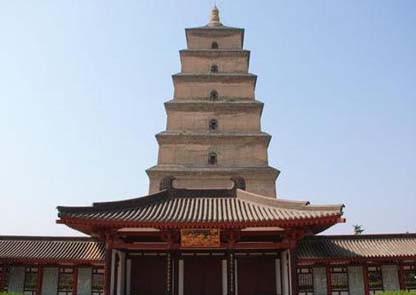The height of the importance of the Silk Road was during the Tang Dynasty (618-907), with relative internal stability in China after the divisions of the earlier dynasties since the Han. The individual states has mostly been assimilated, and the threats from marauding peoples was rather less.
During this period, in the seventh century, the Chinese traveler Xuan Zuang crossed the region on his way to obtain Buddhist scriptures from India. He followed the northern branch round the Taklimakan on his outward journey, and the southern route on his return; he carefully recorded the cultures and styles of Buddhism along the way. On his return to the Tang capital at Chang'an (present Xian City), he was permitted to build the "Big Wild Goose Pagoda" in the southern half of the city, to house the more than 600 scriptures that he had brought back from India. He is still seen by the Chinese as an important influence in the development of Buddhism in China, and his travels were dramatized by in the popular classic "Tales of a Journey to the West".
The art and civilization of the Silk Road achieved its highest point in the Tang Dynasty. Chang'an, as the starting point of the route, as well as the capital of the dynasty, developed into one of the largest and most cosmopolitan cities of the time. By 742, the population had reached almost two million, and the city itself covered almost the same area as present-day Xian, considerably more than within the present walls of the city. In 754, census showed that five thousand foreigners lived in the city; Turks, Iranians, Indians and others from along the Silk Road, as well as Japanese, Koreans and Malays from the east. Many were missionaries, merchants or pilgrims, but every other occupation was also represented. Rare plants, medicines, spices and other goods from the west were to be found in the bazaars of the city. It is quite clear, however, despite the exotic imports, that the Chinese regarded all foreigners as barbarians; the gifts provided for the Emperors by foreign rulers were simply considered as tribute from vassal states.
After the Tang, however, the traffic along the road subsided, along with the grotto building and art of the period. The Five Dynasties period did not maintain the internal stability of the Tang Dynasty, and again neighboring states started to plunder the caravans. China was partially unified again in the Song Dynasty (960-1279), but the Silk Road was not as important as it had been in the Tang.
From the point of view of those in the far west, China was still an unknown territory, and silk production was not understood. Since the days of Alexander the Great, there had been some knowledge of India, but there was no real knowledge of, or contact with, the "Seres" until about the 7th century, when information started to filter along the Silk Road. It was at this time that the rise of Islam started to affect Asia, and a curtain came down between the east and west. Trade relations soon resumed, however, with the Moslems playing the part of middlemen. The sea route to China was explored at this time, and the "Sea Silk Route" was opened, eventually holding a more important place than the land route itself, as the land route became less profitable.
But the final shake-up that occurred was to come from a different direction; the hoards from the grasslands of Mongolia.
|
